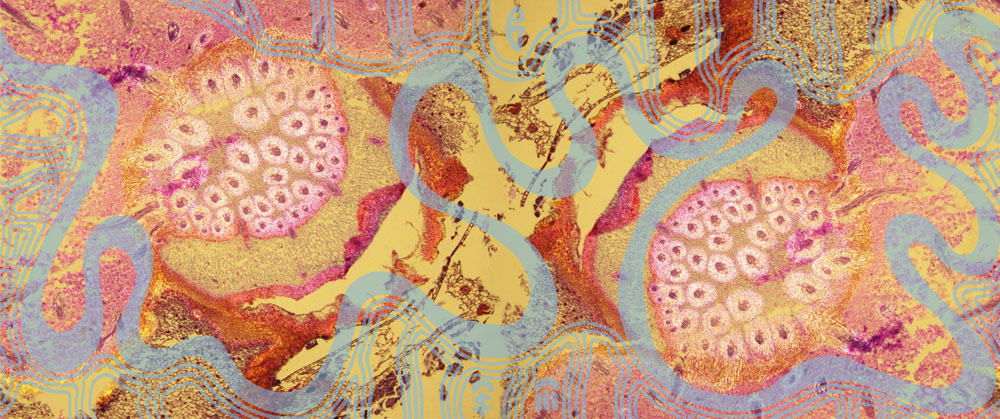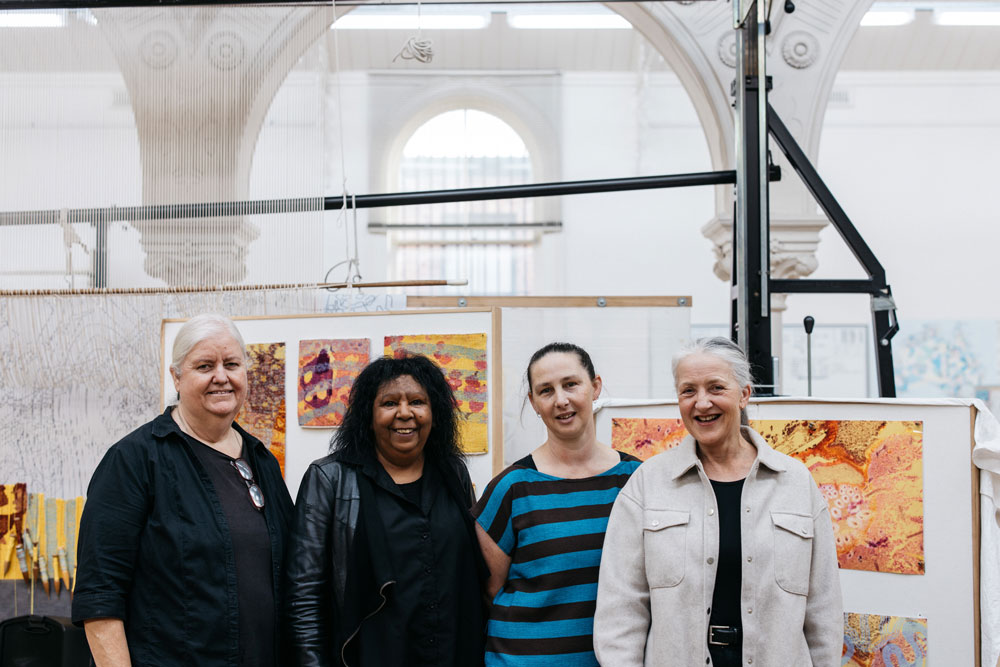



‘Welcome to Country - now you see me: seeing the invisible’, designed by renowned artists Maree Clarke (Yorta Yorta/Wamba Wamba/Mutti Mutti/Boonwurrung) and Mitch Mahoney (Boonwurrung/Barkindji).
The design is inspired by microscopic images of river reeds from the Maribyrnong River. Clarke and Mahoney’s artwork will be transformed into a three-dimensional tapestry spanning 4.2 x 10 metres, making it one of the largest tapestries ever produced for a public hospital in Victoria. The tapestry is also one of the largest ever produced at the ATW and the only tapestry ever woven at the ATW to be suspended in an ellipse installation.
‘Welcome to Country – now you see me: seeing the invisible’ is a tapestry commission supported by The Premier’s Suite partnership for the new Footscray Hospital. The Premier’s Suite is a partnership between the Tapestry Foundation of Australia, the State Government of Victoria and the Australian Hotels Association to fund the production of major tapestry commissions that are gifted to new Victorian hospitals. The new Footscray Hospital tapestry is a collaboration between Plenary Health, the official arts partner for the new hospital, Footscray Community Arts, the Australian Tapestry Workshop, and the Tapestry Foundation of Australia, in collaboration with the Victorian Health Building Authority and Western Health.
Maree Clarke is a Yorta Yorta Wamba Wamba/Mutti Mutti/Boonwurrung woman who is a pivotal figure in the reclamation of southeast Australian Aboriginal art practices, reviving elements of Aboriginal culture that were lost - or lying dormant - over the period of colonisation as well as a leader in nurturing and promoting the diversity of contemporary southeast Aboriginal artists. She is represented by Vivien Anderson Gallery.
Mitch Mahoney is a proud Boon Wurrung artist and cultural educator who consults at Bunjilaka Melbourne Museum, Science Gallery and Footscray Arts Centre. Mitch regularly collaborates with his Aunt, Maree Clarke. Together they have produced significant commissions for the NGV and the Metro Tunnel Project. Mitch is focused on Indigenous Bio-Design in his practice with projects including The Biodegradable Eel Trap and Seven Canoe’s project.
- 14 Victorian-based Australian Tapestry Workshop employees worked on the tapestry:
- 12 weavers
- 2 dyeing specialists
- 2 support staff
- The hand woven tapestry took the Australian Tapestry Workshop weavers over 10,000 hours to complete over a 14-month period.
- The tapestry weaving commenced in April 2024 and was completed in June 2025.
- The tapestry is 42 square metres (4.2m high x 10m wide).
- The tapestry weighs over 135 kilograms.
- The tapestry includes over 270 kilometres of weft yarn (the distance from the new Footscray Hospital to Yarrawonga in north-east Victoria).
- The tapestry used 103 yarn colours (including 8 custom-colours).
Since 2015, the Tapestry Design Prize for Architects (TDPA) has fostered exciting new creative dialogues between architects and tapestry weavers.
In 2023, architects were challenged to design a site specific tapestry for Kerstin Thompson Architect’s Bundanon Art Museum.
Showcasing the resulting ten finalists' designs, sections of these were woven as large format studies by weavers from the Australian Tapestry Workshop (ATW). Leonie Bessant, Chris Cochius, Amy Cornall, Saffron Gordon, Tim Gresham, Pamela Joyce, David Pearce, Emma Sulzer and Caroline Tully all responded individually to a section of each design that inspired or intrigued them. These sections act as propositions - providing a glimpse into their potential as fully realised tapestries.
Recognised as one of Australia’s most significant abstract artists, John Coburn’s work remains as impactful today as it did over his five decades of painting. Paying homage to the long-standing relationship between the Australian Tapestry Workshop and John Coburn, the ATW has woven over 20 Coburn designs.
‘Early Morning Rain’ (1972) designed by John Coburn AM, is the second major commission for the ATW in 2023. ‘Early Morning Rain’ was originally painted as a maquette for tapestry in 1972 but was not realised into woven form until this year.
Over his five-decade career, John Coburn established a reputation and legacy as one of Australia’s most significant abstract artists.
During his career, Coburn regularly designed works for tapestry, the iconic stage curtains at the Sydney Opera House being one example. The Australian Tapestry Workshop has had a long-standing relationship with Coburn and producing over 20 tapestries in our 47-year history. It is due to this connection and depth of experience working with Coburn, that we can bring to life the original maquette for ‘Early Morning Rain.’
Compared to his tapestry collaboration with the French workshops, his designs produced by the then Victorian Tapestry Workshop were categorised by a lively collaboration and fresh approach. The coarser weave of the Gobelin technique used at the Australian Tapestry Workshop gave an increased scope for the rich mixtures of colour and Coburn enjoyed being in conversation with the skilled Australian weavers.
Shape and tone, two keystones of Coburn’s work have continuously tested the skill of the ATW weavers; with the ability to form a beautifully articulated ‘Coburn curves’ and to gently gradate colour through a ‘Coburn shape’ considered the mark of an accomplished weaver.
With a relatively limited palette of 48 colours, the saturated tones and graphic iconography of ‘Early Morning Rain’ are a brilliant example of the abstract artistry of Coburn and will translate beautifully into tapestry.
‘Early Morning Rain’ is led by Tim Gresham and the weavers on this project include Cheryl Thornton, Amy Cornall and David Pearce. It will take approximately 3 months to complete.
We were thrilled to work with artists Emma Biggs and Matthew Collings on ‘Old Media,’ a magnificent large-scale tapestry commissioned for a private collection in the United Kingdom.
Biggs and Collings' responded to a colour palette specified by Paris architect Luis Laplace.
“Colour is important to us. We tried to choose colour that seemed translucent – an illusion of dancing light – a bit like celluloid colour to remind you of the flickering colour you see on film. The apparent transparency of the motifs (the main shapes) is offset by opaque field colours: the blues and greys. It aims to feel uplifting, a bit like a sunset, or a dawn."
"Our paintings usually have a triangle and half-triangle motif, we use it as a vehicle for a rigorously non-figurative experiment with colour and tone. It doesn’t carry meaning. It is just a shape. We felt compelled to change it here because of the place the tapestry is going to be in. The half circles we’ve used, relate to our usual half triangles, but in a vague sort of way they are also connected, in our minds, to the auditorium context. They’re semi-CD. Semi planet. Half-moons. Semi reels of film. Semi spools.” – Emma Biggs & Matthew Collings
Biggs & Collings begun their collaborative practice in 2001 and are internationally renowned for their works in mosaic and abstract, oil-on-canvas paintings informed by art of the past. While they believe art as it used to be understood has come to an end, old ideas and habits remain and inevitably influence the artists of today. The issue of how the past is present in what we, as a society, see and do, and the way in which it may differ from what we believe we say and do, is at the heart of Biggs’ and Collings’ work.
Led by Tim Gresham our eleven weavers translated this design into tapestry, completed in July 2023.
Tim said “Emma and Matthew gave us such a beautiful design to work with. Our focus is on the luminous and translucent quality of the colours. The intense colours and blends where the brush strokes meet are played up in the tapestry, which is scaled up 20 times in size from the design. This increase in size allows for a great deal of creative input from the weaving team, and they are doing an amazing job.”
Spanning two looms the exceptionally large 'Parramatta' tapestry designed by Chris Kenyon has been commissioned as one of many new public artworks destined for the entrances of the new Parramatta Square building in Greater Western Sydney, built by Walker Corporation.
Kenyon is a New South Wales-based, impressionist landscape artist. He uses various painting media to depict nature and landscapes and extracts and dissects strong linear forms. Kenyon is also creating a sculpture of the 'Rose Hill Packet' for the main entrance in Parramatta Square. The 'Rose Hill Packet' was the first ship built by Europeans, designed to carry provisions up the Parramatta River from the fledging settlement of Sydney Cove. In creating his tapestry design, which will welcome visitors to the eastern entrance of the building, Kenyon painted what he imagined to be the viewpoint from the water — as if aboard the vessel — to the river shoreline.
Kenyon researched written descriptions of the region and the earliest sketches and watercolour paintings, done by various artists at the time, including George Raper. Raper, an officer on the first fleet, was an enthusiastic watercolourist, producing around 400 sketches and watercolours of the area. Kenyon writes: The realisation that this was a rich, luxuriantly wooded area made me determined to represent this lushness. I wished to create an atmosphere of golden freshness, with a luminous light reflecting the pure quality of the water, with the Blue Mountains in the background. The level, relatively flat landscape allowed light to penetrate, and so, this feeling of openness was also something I intended to capture.
Kenyon wanted to depict the mystery of the Blue Mountains and the possibility they held to early colonists as a subtle backdrop to the main elements of the landscape. The colonists would have seen the Blue Mountains as a barrier, although the Burramattagal people, the traditional owners of this Country, had traversed them for millennia.
'Parramatta' is the second-largest tapestry woven at the ATW after the Parliament House tapestry designed by Arthur Boyd AC OBE. The tapestry was constructed in two parts as its width is wider than the ATW’s broadest loom. One section is 6.3m wide using 1260 warp threads, and the other is 5.2m using 1040 warp threads. The two parts were joined during installation in Parramatta Square. Due to the four-metre viewing distance the tapestry is woven with a very course warp setting, using two warps per cm and 12 threads on the bobbin. Kenyon’s tapestry design was scaled up ten times, resulting in a 1cm area on the painting becoming a 10cm area on the tapestry. This level of upscaling results in a high level of abstraction of the design, with the capacity for creative interpretation.
Led by Chris Cochius and Pamela Joyce, a thirteen-person weaving team worked collaboratively on this project, with Cochius and Joyce maintaining consistency across the two looms, creating, as they gradually proceed, the strong shapes and high contrast of the landscape. Kenyon encouraged the weaving team to employ their expert knowledge and skills to realise his painting in tapestry form. He was keen for the black lines around the boulders and trees to soften, and the colours warmed up — and he and the weavers discussed creating a sense of depth between the foreground and mountains by making the tones graduate from light at the bottom to dark towards the top of the tapestry.
Commenced in May 2021, the tapestry took 18 months to complete and weighs over 200kgs.
Watch the making of this monumental tapestry here: